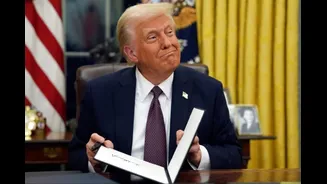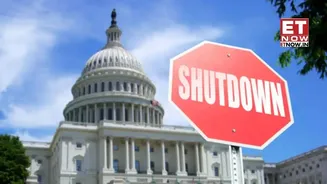Putting his signature to the bill, US President Donald Trump lambasted the Democrats, saying: “Today we are sending a clear message that we will never give in to extortion. This was an easy extension but they didn’t want to do it the easy way. They wanted to do it the hard way.”
Trump’s signing of the spending bill, which provides funding to keep the government open until January 30, will now allow for government services to reopen in the coming day and allow for the return of 670,000 federal workers, who were furloughed for this period of time.
Vote ends America’s longest shutdown
After passing the US Senate, the spending bill was put to a vote in the US House of Representatives on Wednesday, where it passed with a narrow margin — 222 in favour and 209 against, with two not voting.
Six Democrats joined their Republican colleagues to get the bill over the finish line 43 days after the shutdown began: Representatives Henry Cuellar of Texas, Don Davis of North Carolina, Adam Gray of California, Jared Golden of Maine, Marie Gluesenkamp Perez of Washington, and Tom Suozzi of New York.
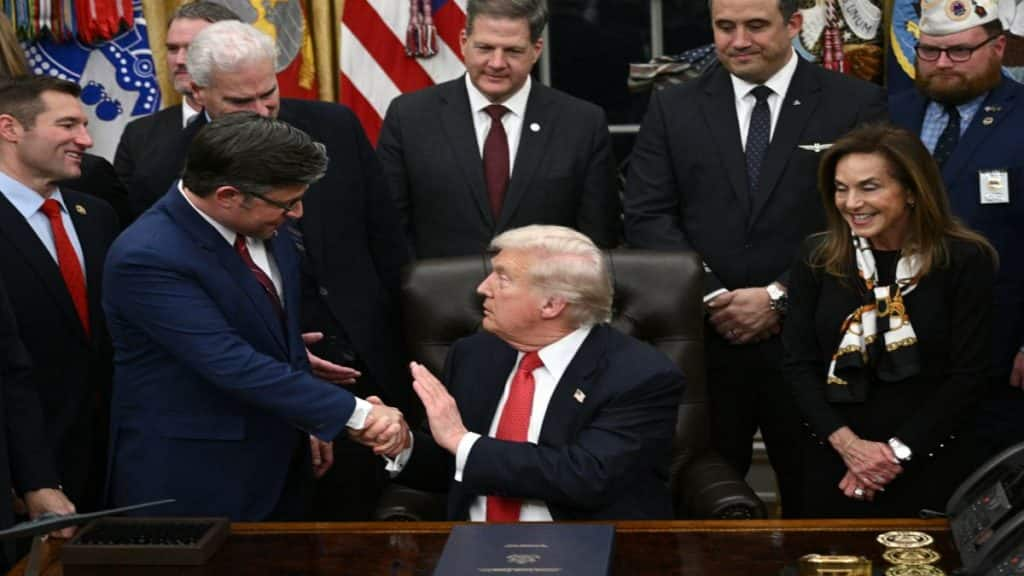
US President Donald Trump shakes hands with the Speaker of the House Mike Johnson after signing the bill package to re-open the federal government in the Oval Office of the White House in Washington, DC. AFP
Don Davis, who broke rank with his party, defended his decision to vote in favour of the bill, saying: “You have to allow an opportunity to talk and allow the negotiations to take its place. I mean, did I want more? Absolutely, I wanted to see more. I would love for us to prepare for the holidays and know that people, their minds are at ease.”
Two Republicans — Thomas Massie of Kentucky and Greg Steube of Florida — went against party lines and voted no.
Shortly after the vote, US President Trump signed the bill, telling Americans: “So I just want to tell the American people, you should not forget this. When we come up to midterms and other things, don’t forget what they’ve done to our country.”
Trump’s signing has now put an end to a long battle which began on October 1 when the shutdown began, resulting in around 700,000 federal workers being furloughed. Hundreds of thousands of others, from active duty military to law enforcement to airport security screeners, remained on the job without pay.
It also resulted in unprecedented disruptions to government services, with the Trump administration ordering cuts to commercial air travel across the country, and the first-ever halt to the largest federal food aid programme.
The spending bill, explained
But what’s exactly in the spending bill that has facilitated the US government shutdown to end? Firstly, the bill, which extends funding until the end of January, includes a reversal of mass firings carried out by the Trump administration against the federal workers since the shutdown began and also ensures that the federal workers receive back their pay.
The legislation also funds the food stamp programme for the rest of the fiscal year, which ends September 30. The Supplemental Nutrition Assistance Program, or SNAP, was thrust into the spotlight during the shutdown after the USDA said it would not dip into a contingency fund to provide at least partial benefits for November.
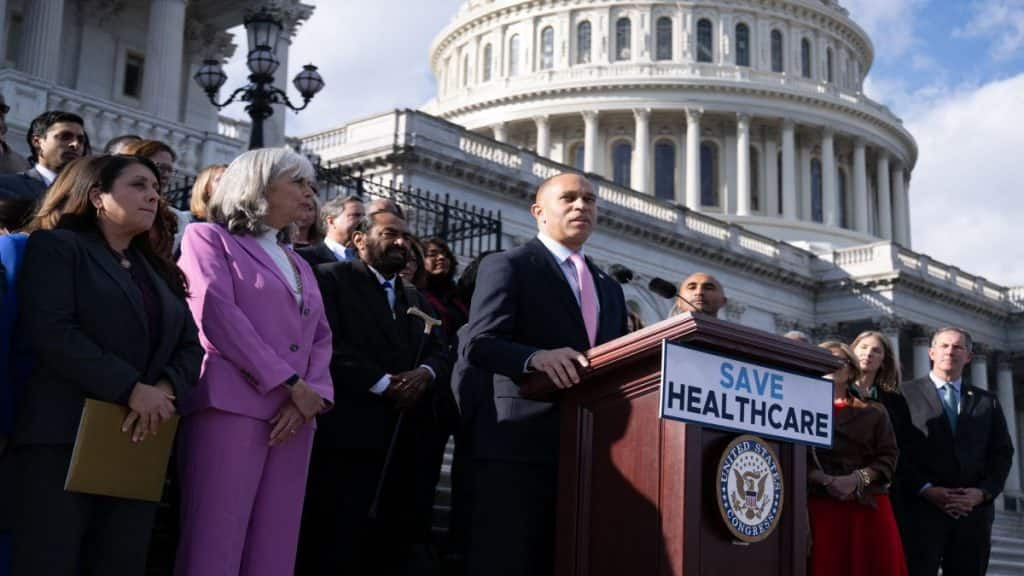
US Minority Leader Hakeem Jeffries, Democrat of New York, speaks alongside Democratic members of the House of Representatives about health care and the planned vote to end the government shutdown during a press conference outside the US Capitol in Washington, DC. AFP
Legal battles ensued, resulting in some of the nation’s nearly 42 million food stamp beneficiaries receiving their full allocations over the past week, others receiving partial benefits and still others waiting for any assistance. The deal will also replenish SNAP’s contingency fund and fully funds child nutrition programmes, including free and reduced-price school meals.
The bill also includes a section that requires the Justice Department and FBI to notify the Senate when a lawmaker is under investigation and if their personal information is being subpoenaed.
Moreover, the package includes $203.5 million to boost security for lawmakers and an additional $28 million for the security of Supreme Court justices.
The biggest point of contention in the spending bill was the fate of the expiring enhanced tax credit that makes health insurance more affordable through Affordable Care Act marketplaces.
Democrats such as Nancy Pelosi argue that the enhanced tax credit is designed to give more people access to health care. “All they have done is try to eliminate access to health care in our country. The country is catching on to them,” Pelosi said.
Without the enhanced tax credit, premiums on average will more than double for millions of Americans. More than two million people would lose health insurance coverage altogether next year, the Congressional Budget Office has projected.
Government services to resume slowly
Now, the longest US government has come to an end, but Americans will have to wait for programmes to restart fully. As per federal law, workers whose paycheques were paused should be made whole. In the past, it has taken about a week for unpaid workers to receive back pay, though the Office of Personnel Management said it varies by agency.
US Transportation Secretary Sean Duffy has said that air traffic controllers will receive the first 70 per cent of their back pay within 24 to 48 hours of the shutdown ending, but it is not clear if other parts of the government will be on a similar schedule.
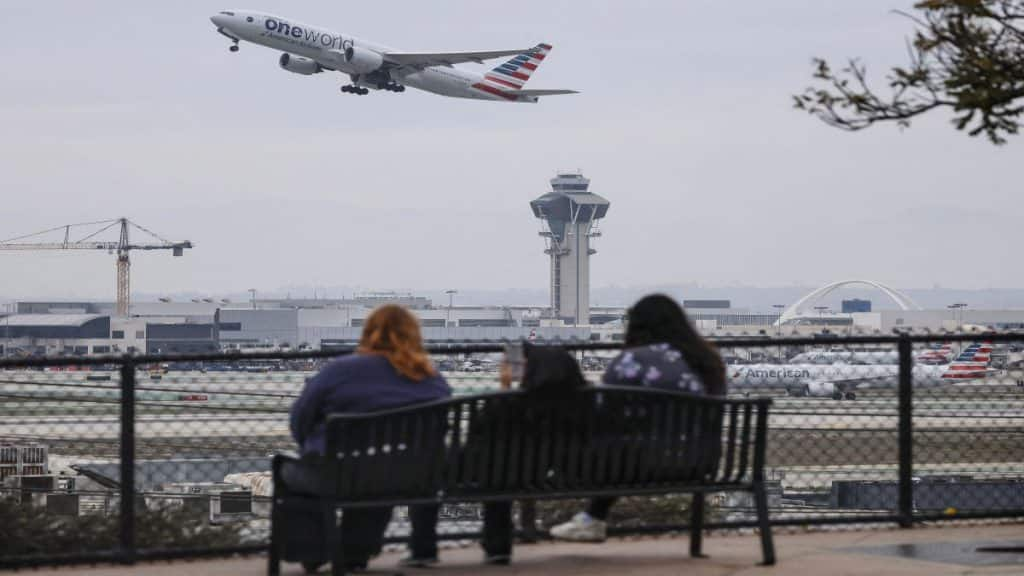
People watch as an American Airlines plane takes off near the air traffic control tower at Los Angeles International Airport (LAX). Airline insiders and the Trump administration have noted that the flight cuts will take time to settle. File image/AFP
When it comes to Snap, a spokeswoman for the White House’s budget office insisted this week that beneficiaries will see their accounts fully restored within hours of the federal government reopening.
Airline insiders and the Trump administration have noted that the
It remains unclear how long before the US museum, the Smithsonian, will reopen to the public.
The government shutdown, which forced the shuttering of the statistical agencies that produce data on employment, inflation, consumer spending and other aspects of the economy, will also now reopen. The Bureau of Labour Statistics will probably be able to release job market data from September within a few days of the government reopening. Other reports on September, such as data on retail sales, could also come out relatively quickly.
But the data when released, may come with an asterisk. Many government statistics are based on surveys of households and businesses; when those surveys are delayed, there is a risk that people won’t accurately remember what they were doing during the relevant period.
With inputs from agencies


